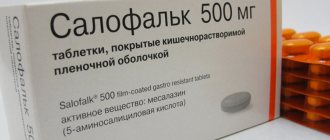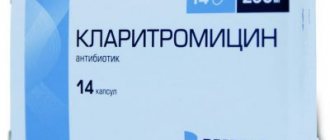Compound
Active ingredient: mesalazine;
1 sachet (930 mg granules) contains 500 mg mesalazine or 1 sachet (1860 mg granules) contains 1000 mg mesalazine;
Excipients: microcrystalline cellulose, hypromellose, colloidal silicon dioxide, polyacrylate dispersion, magnesium stearate, simethicone emulsion, methacrylate copolymer (type A), triethyl citrate, talc, titanium dioxide (E 171), sodium carboxymethylcellulose, aspartame (E 951), citric acid acid, sweet vanilla flavor, povidone.
Salofalk 1000 mg 50 pcs. enteric coated granules
Composition and release form Salofalk 1000 mg 50 pcs. enteric coated granules
Granules 500 mg - 1 pack.
- active ingredients: mesalazine (5-ASA) - 500 mg;
- Excipients: microcrystalline cellulose - 200 mg, hypromellose - 18 mg, colloidal anhydrous silicon dioxide - 0.25 mg, Eudrazite NE40D (40% dispersion of copolymer of methyl methacrylate and ethyl acrylate (2:1) and 2% nonoxynol) - 45 mg, magnesium stearate - 7.75 mg, dry matter 33% simethicone emulsion (consists of 92% simethicone, 7.7% methylcellulose, 0.3% sorbic acid) - 0.5 mg.
- Composition of the inner shell: hypromellose - 2 mg, copolymer of methacrylic acid and methyl methacrylate (1:1) (eudragit L100) - 75 mg, triethyl citrate - 7.5 mg, talc - 20 mg, magnesium stearate - 5 mg, titanium dioxide - 12.5 mg.
- Composition of the outer shell: carmellose sodium - 15 mg, titanium dioxide - 5 mg, aspartame - 1 mg, anhydrous citric acid - 3 mg, vanilla flavor - 2 mg, talc - 5.5 mg, povidone K25 - 5 mg.
930 mg - plastic bags laminated with aluminum foil (50) - cardboard packs.
930 mg - plastic bags laminated with aluminum foil (50) - cardboard packs (2) - cardboard boxes.
Granules 500 mg - 1 pack.
- active ingredients: mesalazine (5-ASA) - 1000 mg;
- Excipients: microcrystalline cellulose - 400 mg, hypromellose - 36 mg, colloidal anhydrous silicon dioxide - 0.5 mg, Eudrazite NE40D (40% dispersion of copolymer of methyl methacrylate and ethacrylate (2:1) and 2% nonoxynol) - 90 mg, magnesium stearate - 15.5 mg, dry matter 33% simethicone emulsion (consists of 92% simethicone, 7.7% methylcellulose, 0.3% sorbic acid) - 1 mg.
- Composition of the inner shell: hypromellose - 4 mg, copolymer of methacrylic acid and methyl methacrylate (1:1) (eudragit L100) - 150 mg, triethyl citrate - 15 mg, talc - 40 mg, magnesium stearate - 10 mg, titanium dioxide - 25 mg.
- Composition of the outer shell: carmellose sodium - 30 mg, titanium dioxide - 10 mg, aspartame - 2 mg, anhydrous citric acid - 6 mg, vanilla flavor - 4 mg, talc - 11 mg, povidone K25 - 10 mg.
1860 mg - plastic bags laminated with aluminum foil (50) - cardboard packs.
1860 mg - plastic bags laminated with aluminum foil (50) - cardboard packs (2) - cardboard boxes.
Description of the dosage form
Granules 500 mg, enteric-coated, long-acting, grayish-white, round, cylindrical or spherical in shape.
Granules 1000 mg, enteric-coated, long-acting, grayish-white, round, cylindrical or spherical in shape.
Directions for use and doses
The dosage regimen for the treatment of exacerbation of ulcerative colitis depends on the clinical need and is individual in each case. Prescribe 1 sachet of 500-1000 mg of mesalazine 3 times a day or 3 sachets 1 time a day (corresponding to 1.5-3.0 g of mesalazine per day).
To maintain remission of ulcerative colitis, 500 mg (1 sachet) of mesalazine is prescribed 3 times a day or 3 sachets of 500 mg 1 time/day (corresponding to 1.5 g of mesalazine per day).
Pharmacodynamics
Has an anti-inflammatory effect. Inhibits the synthesis of arachidonic acid (PG) metabolites, the activity of neutrophil lipoxygenase, inhibits the migration, degranulation and phagocytosis of neutrophils, the secretion of immunoglobulins by lymphocytes; binds and destroys oxygen free radicals.
Pharmacokinetics
Release of mesalazine occurs in the terminal part of the small intestine and in the large intestine. The tablets begin to dissolve in the small intestine after 110-170 minutes and completely dissolve 165-225 minutes after administration. The dissolution rate is not affected by changes in pH caused by food or other drugs. It is metabolized into N-acetyl-5-aminosalicylic acid already in the intestinal mucosa and liver, so the concentration in plasma is relatively low (after taking 250 mg - 0.5-1.5 μg/ml). Binds to plasma proteins by 43% (metabolite - by 75-83%). 0.1% of the dose penetrates into mother's milk (in the form of a metabolite).
Indications for use Salofalk 1000 mg 50 pcs. enteric coated granules
Nonspecific ulcerative colitis and Crohn's disease.
Contraindications
- blood diseases;
- severe dysfunction of the liver and/or kidneys;
- hypersensitivity to the drug.
Application of Salofalk 1000 mg 50 pcs. enteric coated granules during pregnancy and breastfeeding
Contraindicated during pregnancy, breastfeeding and children under 2 years of age.
Overdose
No cases of overdose have been identified. In case of overdose, symptomatic treatment is carried out.
Side effects Salofalk 1000 mg 50 pcs. enteric coated granules
- diarrhea, nausea, heartburn, abdominal pain;
- headache, sleep disturbances;
- skin rash, itching;
- disturbance of the blood picture.
Drug interactions
Causes an increase in the effect of anticoagulants and the hypoglycemic effect of sulfonylurea derivatives; increases the toxicity of methotrexate, enhances the damaging effect of GCS on the gastric mucosa, reduces the tuberculostatic effect of rifampicin, the uricosuric effect of probenecid and sulfinpyrazone, the diuretic effect of spironolactone and furosemide.
Mode of application
Salofalk granules cannot be chewed. The contents of a Grane-Stix 500 mg or 1000 mg sachet should be poured onto the tongue and swallowed with a sufficient amount of liquid without chewing.
Both in the treatment of exacerbations of inflammation, and during long-term treatment, Salofalk granules should be used regularly and continuously to achieve the desired therapeutic effect.
Typically, exacerbations of ulcerative colitis subside within 8-12 weeks; for most patients, the dose can be reduced to a maintenance dose.
The duration of use is determined by the doctor.
Salofalk
Before starting treatment, during, and after treatment, a general blood and urine test is necessary.
Before starting treatment and during its implementation, it is necessary to determine parameters of the functional state of the liver (such as ALT or AST activity) and monitor urine tests (using immersion test strips). Monitoring is usually recommended 14 days after the start of treatment, then 2-3 more times with an interval of 4 weeks. If test results are normal, follow-up studies should be performed every 3 months. If additional symptoms occur, follow-up studies should be performed immediately.
Use with caution in patients with impaired liver function.
The use of Salofalk is not recommended for patients with severe renal impairment. If renal dysfunction develops during treatment, the nephrotoxic effect of mesalazine should be considered. During treatment, renal function should be monitored.
When prescribing Salofalk to patients with lung diseases, in particular bronchial asthma, it is necessary to exercise careful monitoring during treatment.
Patients with a history of indications of adverse reactions when prescribed drugs containing sulfasalazine are subject to careful monitoring during the initial period of treatment with Salofalk. If, during treatment with Salofalk, acute intolerance reactions occur, such as cramps, acute abdominal pain, fever, severe headache and rash, use of the drug must be stopped immediately.
Patients who are “slow acetylators” have an increased risk of developing side effects.
There may be a yellow-orange coloration of urine and tears, and staining of soft contact lenses.
If several doses are missed, the patient should consult a doctor without stopping treatment.
When prescribing the drug to patients suffering from phenylketonuria, it should be remembered that Salofalk granules contain aspartame in doses equivalent to the following amount of phenylalanine: 0.56 mg (Salofalk granules 500 mg), 1.12 mg (Salofalk granules 1 g).
Use in pediatrics
Salofalk granules should not be administered to children under 6 years of age.
, since experience with the drug in patients in this age group is very limited.
Impact on the ability to drive vehicles and operate machinery
Care should be taken when driving a vehicle and engaging in potentially hazardous activities that require increased concentration and speed of psychomotor reaction.
Note!
Description of the drug Salofalk gran. gastro. prol. d-viya pack. 500 mg No. 50 on this page is a simplified author’s version of the apteka911 website, created on the basis of the instructions for use.
Before purchasing or using the drug, you should consult your doctor and read the manufacturer's original instructions (attached to each package of the drug). Information about the drug is provided for informational purposes only and should not be used as a guide to self-medication. Only a doctor can decide to prescribe the drug, as well as determine the dose and methods of its use.
Salofalk 500 mg 50 pcs. enteric coated granules
Composition and release form Salofalk 500 mg 50 pcs. enteric coated granules
Granules 500 mg - 1 pack.
- active ingredients: mesalazine (5-ASA) - 500 mg;
- Excipients: microcrystalline cellulose - 200 mg, hypromellose - 18 mg, colloidal anhydrous silicon dioxide - 0.25 mg, Eudrazite NE40D (40% dispersion of copolymer of methyl methacrylate and ethyl acrylate (2:1) and 2% nonoxynol) - 45 mg, magnesium stearate - 7.75 mg, dry matter 33% simethicone emulsion (consists of 92% simethicone, 7.7% methylcellulose, 0.3% sorbic acid) - 0.5 mg.
- Composition of the inner shell: hypromellose - 2 mg, copolymer of methacrylic acid and methyl methacrylate (1:1) (eudragit L100) - 75 mg, triethyl citrate - 7.5 mg, talc - 20 mg, magnesium stearate - 5 mg, titanium dioxide - 12.5 mg.
- Composition of the outer shell: carmellose sodium - 15 mg, titanium dioxide - 5 mg, aspartame - 1 mg, anhydrous citric acid - 3 mg, vanilla flavor - 2 mg, talc - 5.5 mg, povidone K25 - 5 mg.
930 mg - plastic bags laminated with aluminum foil (50) - cardboard packs.
930 mg - plastic bags laminated with aluminum foil (50) - cardboard packs (2) - cardboard boxes.
Granules 500 mg - 1 pack.
- active ingredients: mesalazine (5-ASA) - 1000 mg;
- Excipients: microcrystalline cellulose - 400 mg, hypromellose - 36 mg, colloidal anhydrous silicon dioxide - 0.5 mg, Eudrazite NE40D (40% dispersion of copolymer of methyl methacrylate and ethacrylate (2:1) and 2% nonoxynol) - 90 mg, magnesium stearate - 15.5 mg, dry matter 33% simethicone emulsion (consists of 92% simethicone, 7.7% methylcellulose, 0.3% sorbic acid) - 1 mg.
- Composition of the inner shell: hypromellose - 4 mg, copolymer of methacrylic acid and methyl methacrylate (1:1) (eudragit L100) - 150 mg, triethyl citrate - 15 mg, talc - 40 mg, magnesium stearate - 10 mg, titanium dioxide - 25 mg.
- Composition of the outer shell: carmellose sodium - 30 mg, titanium dioxide - 10 mg, aspartame - 2 mg, anhydrous citric acid - 6 mg, vanilla flavor - 4 mg, talc - 11 mg, povidone K25 - 10 mg.
1860 mg - plastic bags laminated with aluminum foil (50) - cardboard packs.
1860 mg - plastic bags laminated with aluminum foil (50) - cardboard packs (2) - cardboard boxes.
Description of the dosage form
Granules 500 mg, enteric-coated, long-acting, grayish-white, round, cylindrical or spherical in shape.
Granules 1000 mg, enteric-coated, long-acting, grayish-white, round, cylindrical or spherical in shape.
Directions for use and doses
The dosage regimen for the treatment of exacerbation of ulcerative colitis depends on the clinical need and is individual in each case. Prescribe 1 sachet of 500-1000 mg of mesalazine 3 times a day or 3 sachets 1 time a day (corresponding to 1.5-3.0 g of mesalazine per day).
To maintain remission of ulcerative colitis, 500 mg (1 sachet) of mesalazine is prescribed 3 times a day or 3 sachets of 500 mg 1 time/day (corresponding to 1.5 g of mesalazine per day).
Pharmacodynamics
Has an anti-inflammatory effect. Inhibits the synthesis of arachidonic acid (PG) metabolites, the activity of neutrophil lipoxygenase, inhibits the migration, degranulation and phagocytosis of neutrophils, the secretion of immunoglobulins by lymphocytes; binds and destroys oxygen free radicals.
Pharmacokinetics
Release of mesalazine occurs in the terminal part of the small intestine and in the large intestine. The tablets begin to dissolve in the small intestine after 110-170 minutes and completely dissolve 165-225 minutes after administration. The dissolution rate is not affected by changes in pH caused by food or other drugs. It is metabolized into N-acetyl-5-aminosalicylic acid already in the intestinal mucosa and liver, so the concentration in plasma is relatively low (after taking 250 mg - 0.5-1.5 μg/ml). Binds to plasma proteins by 43% (metabolite - by 75-83%). 0.1% of the dose penetrates into mother's milk (in the form of a metabolite).
Indications for use Salofalk 500 mg 50 pcs. enteric coated granules
Nonspecific ulcerative colitis and Crohn's disease.
Contraindications
- blood diseases;
- severe dysfunction of the liver and/or kidneys;
- hypersensitivity to the drug.
Application of Salofalk 500 mg 50 pcs. enteric coated granules during pregnancy and breastfeeding
Contraindicated during pregnancy, breastfeeding and children under 2 years of age.
Overdose
No cases of overdose have been identified. In case of overdose, symptomatic treatment is carried out.
Side effects Salofalk 500 mg 50 pcs. enteric coated granules
- diarrhea, nausea, heartburn, abdominal pain;
- headache, sleep disturbances;
- skin rash, itching;
- disturbance of the blood picture.
Drug interactions
Causes an increase in the effect of anticoagulants and the hypoglycemic effect of sulfonylurea derivatives; increases the toxicity of methotrexate, enhances the damaging effect of GCS on the gastric mucosa, reduces the tuberculostatic effect of rifampicin, the uricosuric effect of probenecid and sulfinpyrazone, the diuretic effect of spironolactone and furosemide.



